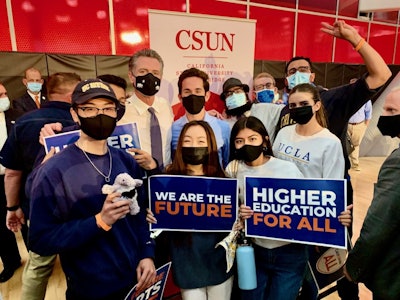 California Governor Gavin Newsom signed package of higher education bills.
California Governor Gavin Newsom signed package of higher education bills.
“What we’ve seen in the budget and the bills that the Governor signed is a real commitment to address students where they are,” said Joey Freeman, chief deputy legislative affairs secretary at the Governor’s Office. “COVID has been an inflection point in terms of workforce needs and what the economy looks like. Now more than ever is the time to make college more affordable, to provide opportunities for people to get the skills they need.”
Advocacy groups and the Governor’s office note the significance of this legislation coming more than a year after the pandemic brought equity gaps to the fore.
“What we know is that a Bachelor’s degree continues to have value for individuals,” said Audrey Dow, senior vice president at the Campaign for College Opportunity, an advocacy and policy research group focused on college access in California. “College is still worth it, and the pandemic once again proved that.”
Dow pointed out that during the height of the pandemic, students with a bachelor’s degree were more likely to stay employed and work from home. They also were more likely to have health insurance.
“In many ways, having a bachelor’s degree saved lives,” said Dow. “Right now, more than ever, we are reminded of how important it is for individuals seeking that degree to be able to get it.” California Governor Gavin Newsom
California Governor Gavin Newsom
According to studies, the vast majority of people who enroll in two-year community colleges in California intend to transfer to a four-year institution to earn a bachelor’s degree. Yet less than 4% of community college students transfer in two years, and about 19% transfer in four years. To the Governor’s Office, these numbers underscore a dysfunctional system that has for years been leaving many students out.
“The goal of these bills is to dramatically improve those numbers,” said Freeman, referring to the AB 928 and AB 1111 bills. “California prides itself on its system of higher education, but we know that not all students have the same access.”
Those two bills together help streamline community college students’ path to the University of California (UC) and California State University (CSU) systems. With the California community college system serving about two million students, advocates like Dow say that reforming what has been called the “transfer maze” will be historic.
Among the package’s other bills are reforms that combat student housing insecurity as well as improve financial aid education and outreach to low-income students. The bill AB 469, for example, will now require that high school students complete a college financial aid form—either the Free Application for Federal Student Aid (FAFSA) or California Dream Act Application (CDAA), which offers state aid to eligible undocumented students.
“We’re excited about that bill because the Governor not only signed it but put resources behind it to make sure schools can actually implement it,” said Dr. Christopher Nellum, executive director of the education advocacy group The Education Trust-West. “We see this as a college access issue.”
A 2018 survey from the U.S. Department of Education found that among students across the country who did not complete their financial aid applications, about 15% of them did not know about the FAFSA. Another 23% did not have enough information on how to finish the form. So, to advocates like Nellum, bills that improve financial aid literacy and make it easier for students to complete this paperwork can make a difference in getting low-income communities to college.
“Our perspective is that Governor Newsom generally took advantage of this opportunity to move forward a lot of equity-minded proposals,” said Nellum. “Looking towards the future, it really now is about implementation. How are school districts and higher education institutions partnering to make sure we can make these pieces of legislation a reality.”
Nellum did point out one disappointment, however. Newsom vetoed a bill, AB 1456, that proposed to overhaul Cal Grant, the state’s financial aid program.
“I agree with the author that making the Cal Grant program simpler to navigate would benefit our students and their families,” said the Governor in a statement on his veto. “However, this bill results in significant cost pressures to the state, likely in the hundreds of millions of dollars annually. Future changes to the financial aid system of this magnitude should be considered as a part of the annual budget process.”
But Nellum said he hopes to see progress on Cal Grant reform in upcoming budget talks.
“It feels like the Governor, although he is an education equity champion, missed an opportunity here,” he said. “But we’re looking forward to next year and working through state aid reforms with our partners, continuing to push them through.”
Moving forward with the bills that have made it through, Dow at the Campaign for College Opportunity added that a challenge will now be bringing back community college students who dropped out during the pandemic. Yet she is hopeful.
“What we have to tell them is that you can come back to a system that is better for you,” said Dow. “And it won’t take six years for you to finish. When you get to community college, you will complete, and you will complete on time. That’s an important message for students to hear right now.”
Rebecca Kelliher can be reached at [email protected].



















